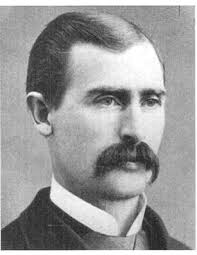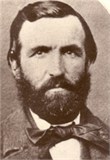Moses Thatcher
1842-1909
Moses Thatcher, sixth son of eight sons of Hezekiah Thatcher and Alley Kitchen, was born on February 2, 1842, in Sangamon County, Illinois.
The frightening turmoil of the Saints’ exodus from Nauvoo, Illinois, the misery, sickness hunger and death that hung like a cloud over the camps of wandering Mormons, the blistering sun, and unquenched thirst that accompanied his barefoot trek across the plains, and witnessing the death of his childhood chum as he lay crushed under a rolling log…all these deeply impressed young Moses. But overriding the challenges and trials of his early life was his abiding faith in a benevolent God, a faith inculcated in him early in his tender years by his faithful, trusting mother.
Not forgotten were his memories of early encounters with Indians, one in which he was forced to exchange some cherished corn cakes for less palatable cricket pies.
With other members of his father’s family, Moses was taken to California in the spring of 1849, where they settled in the area of Sacramento, a village of rude huts and unprotected tents, where people kept their silver dollars sewn in gunny sacks under their beds.
He attended his first school when he was eleven. Large for his age, he was humiliated to realize that boys much smaller and younger than he were far ahead of him in class, and so he exerted extra effort to excel. When not in school, he earned money by digging moss and dirt from the crevices of large rocks along the river. In a milk pan he washed the moss and dirt and retrieved gold dust which netted him several dollars a day.
His chief delight, however, was found in frequent night religious meetings which he and his parents attended. He listed with pride as his father explained the Gospel to non-believers and as his mother confounded religious leaders with her simple, direct, unwavering faith.
When at 15 Moses accepted the call to serve as missionary companion to elder Henry G. Boyle, it was with the understanding that he would be just that, a companion. He would not be required to proselyte. However, within a short time, he was amazed that he was blessed to be able to defend eloquently and knowledgeably the Gospel, not only to friends but to complete strangers.
Lettie Farr became his bride in April 1861, and they settled in Cache Valley, building the first frame house in Logan, Utah. There Moses joined the “Minute Men” peacekeeping force.
He was called on a mission to Salt Lake City to learn telegraphy in 1865, and in April 1866 was called on a proselyting mission to England. Upon his release in August 1868, he returned to Logan where he entered into a mercantile business with his father, a business that was later incorporated into ZCMI. He became influential in business and politics in Utah and was a member of the Utah Constitutional Convention of 1872 and a delegate to present the proposed constitution to Congress. Moses was called as the first President of the Cache Valley Stake on May 21, 1877, and on April 9, 1879, at the age of 37, was called as an Apostle of the Church of Jesus Christ of Latter-day Saints.
Because an influential Greek-Mexican, Dr. Plotino Rhodakanaty, residing in Mexico City, had become interested in the Gospel and had written to President John Taylor requesting additional information about the Church, Moses Thatcher was sent to Mexico City to meet with him personally. He was accompanied by Meliton Gonzalez Trejo, the Spanish translator of the Book of Mormon, and by James Z. Stewart. Soon after they arrived in Mexico City, in November 1879, they taught and baptized Dr. Rhodakanaty and a native Mexican, Silviano Arteaga. Within a few days they had baptized six additional men, had formed a Branch of the Church, had invoked the Lord’s blessings on Porfirio Diaz, the Mexican Constitution and governing bodies of the country of Mexico and its inhabitants that they might hear and receive the Gospel message, and Moses Thatcher additionally dedicated the land to missionary work.
During this introductory visit to Mexico, Apostle Thatcher became acquainted with many prominent educational and political leaders in Mexico and he absorbed all the knowledge he could on the history and customs of this fascinating and powerful country. In his contacts with government officials, he laid the groundwork for the legal acquisition of lands in northern Mexico by the Mormon Colonists.
In 1882 he and Erastus Snow were called to explore northern Mexico with a view to acquiring land there for possible colonization. When in 1885 the first Mormon settlers moved into northern Chihuahua, alarmed American residents of Chihuahua prevailed upon the governor to issue an order for expulsion of the Mormons. Apostles Thatcher and Brigham Young Jr. were able to have the order rescinded in Mexico City, where the matter had been referred.
Moses Thatcher was called to assist Elder Erastus Snow, who had been given charge of the Mormon colonies, in the adjustment of the Saints’ property titles and in the purchase of additional lands for their use. Because of the time he had spent in Mexico City subsequent to his first, time which included a mission in that area, he had come to know intimately many of the political leaders there, and his service to the colonists was invaluable. Also, he was able to obtain needed machinery for the Saints and arrange for its importation to Mexico.
At the request of Elder Snow, Moses Thatcher dedicated the townsite of Colonia Juarez on January 1, 1887. In the years that followed, until his death in 1909, Thatcher maintained a lively interest in the colonies, visiting them often and contributing to their growth and development.
Jeanne J. Hatch
Stalwarts South of the Border, Nelle Spilsbury Hatch,
page 696



